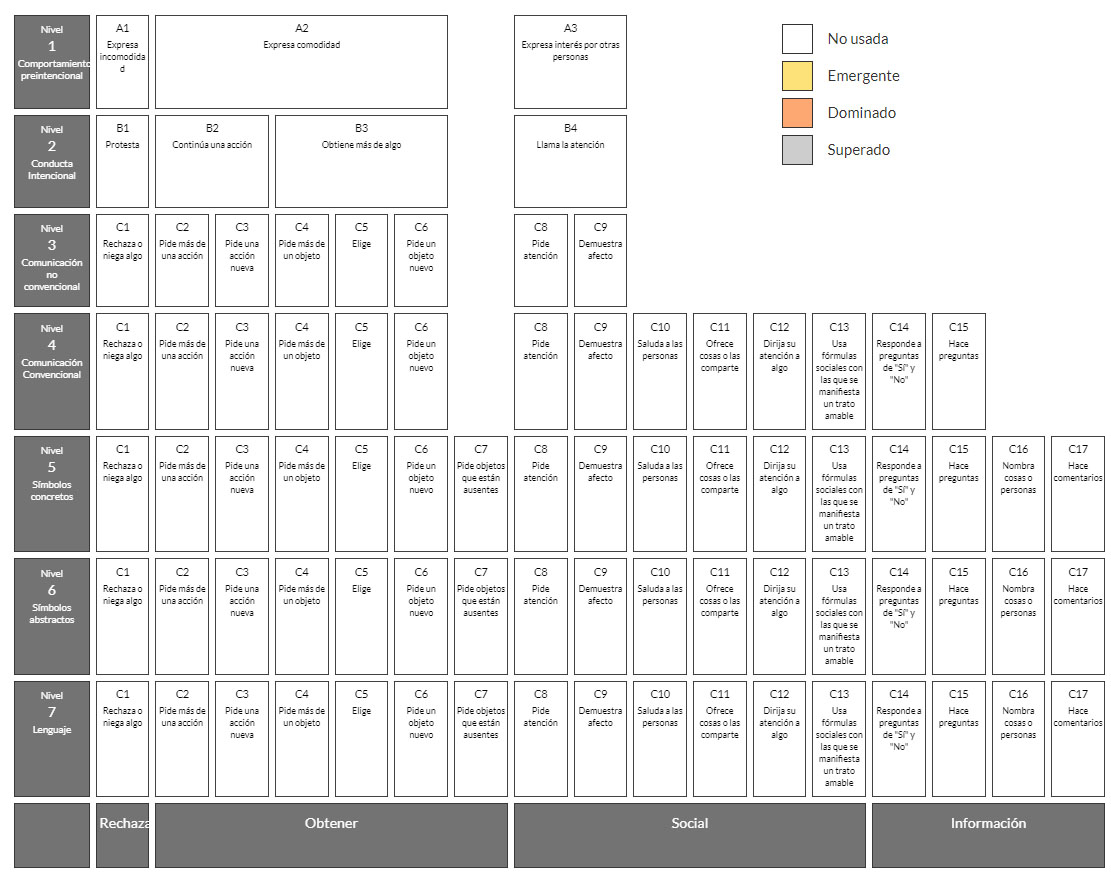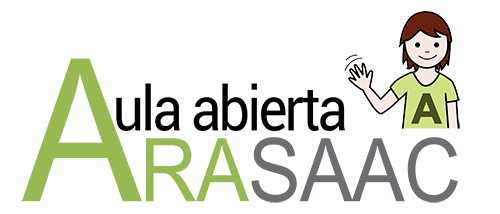 This work is licensed under a Creative Commons Attribution-NonComercial-ShareAlike 4.0 International license.
This work is licensed under a Creative Commons Attribution-NonComercial-ShareAlike 4.0 International license.
1. WE TEACH AND ENABLE AN INCREASED AND ALTERNATIVE COMMUNICATION SYSTEM (AAC)
Communication and language are essential for human beings and allow them to interact with others, learn, enjoy and participate in the society in which they live. Sometimes, speech and / or language may be affected, and as a consequence, communication can be compromised by different factors (autism, intellectual disability, lack of knowledge of the language, degenerative diseases, etc.), making it difficult for them to be included in any setting. of everyday life.
For this reason, regardless of age or type of disability, if they have limitations in oral communication, they need to use an Augmentative and Alternative Communication System (SAAC).

AACs are not incompatible but complementary to language rehabilitation, and can also help its success when it is not possible. Therefore, it should not be hesitated to introduce it at an early age, as soon as difficulties are observed in the development of language. There is no evidence that the use of CAA inhibits or interferes with the development or recovery of language “(What is AAC? – ARASAAC – Carmen Basil).
Before addressing which is the most appropriate augmentative and alternative communication system (AAC) for a person, we must carry out an exhaustiveevaluation process, to guarantee the success of its implementation.
- Identify the capacities, abilities, needs and interests of the user, a fundamental basis for establishing intervention and participation plans. We are not interested in the deficits or difficulties of the person, but in the functionality that is intended to be achieved with the implementation of the SAAC.
- Visualize the SAAC user as an active and participatory person who interacts and assumes responsibilities in the daily activities that they carry out in the usual environment in which they operate (ecological approach).

Once this evaluation process is complete, we will begin the process of
qualification and teaching of AAC taking into account the full
Information obtained about the user
and its environment, which will allow us to define what the
AAC components (graphic gesture symbols), assistive products (basic or technological), access strategies (direct selection or sweeping), acccso products (pushbutton, gaze control, joystick, …) and the choice of appropriate vocabulary .
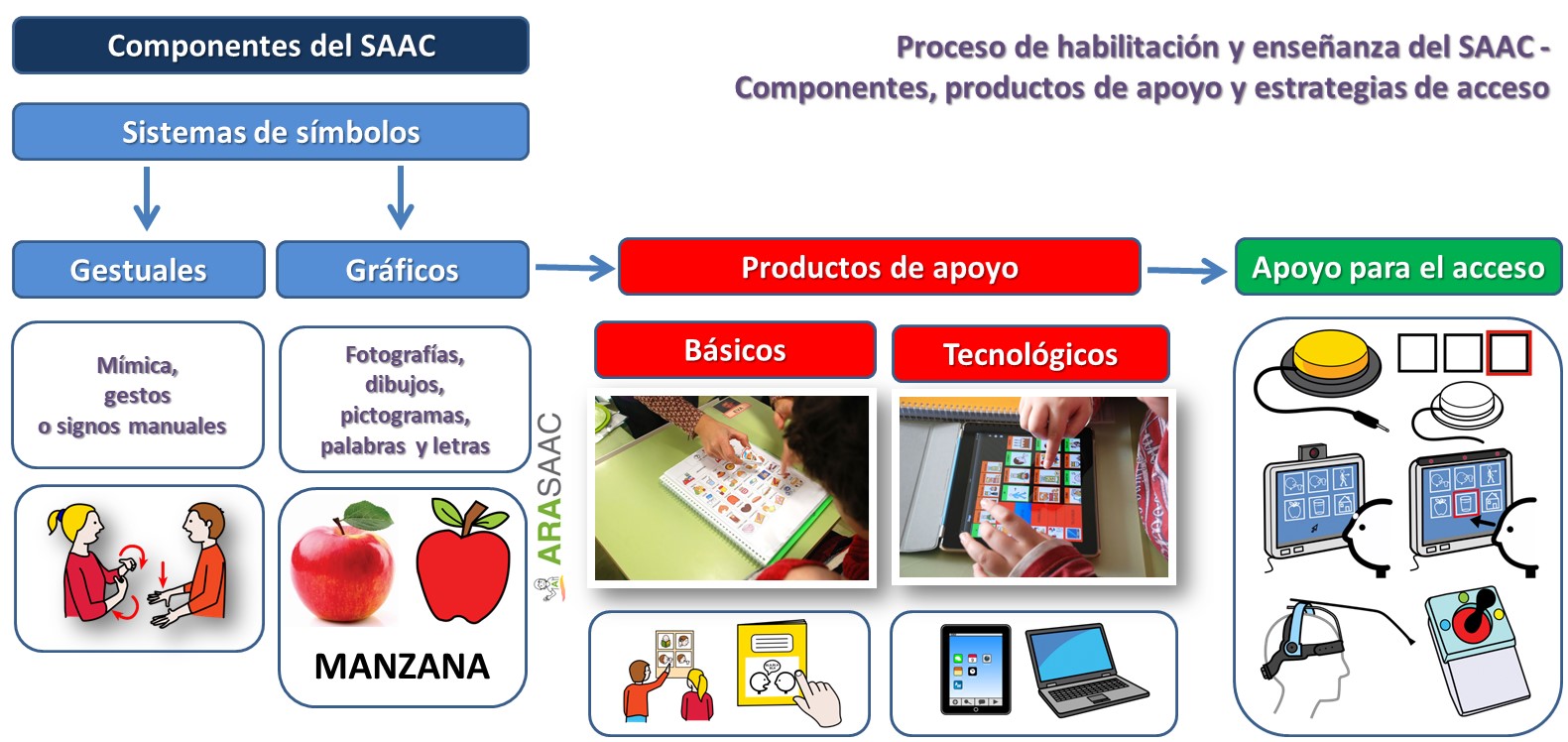
Regarding the choice of vocabulary for the SAAC, we must take into account a series of basic criteria:
- Evolutionary approach: age-appropriate vocabulary
- Ecological approach: vocabulary needed according to the context
- Personalization based on the interests and reality of the user. Some of the categories that require more customization, adding vocabulary from the beginning, are: people (family members, colleagues, professionals …), places (places you usually go and are not included in the default vocabulary), games and sports (toys or games that are of interest to the user). Vocabulary customization can be a key element to the success of any augmentative communication system.
- Functional communication: expression of demands, but also other communicative functions such as asking, explaining, refuting, joking, nuancing, etc.
- Linguistic development: lexical diversity, extension of statements, etc.
- Selection of more symbolic pictograms: choose pictograms with “stick” people (schematic) rather than more concrete and detailed pictograms.
- Selection of pictograms without color, except if the color is something characteristic or inborn.
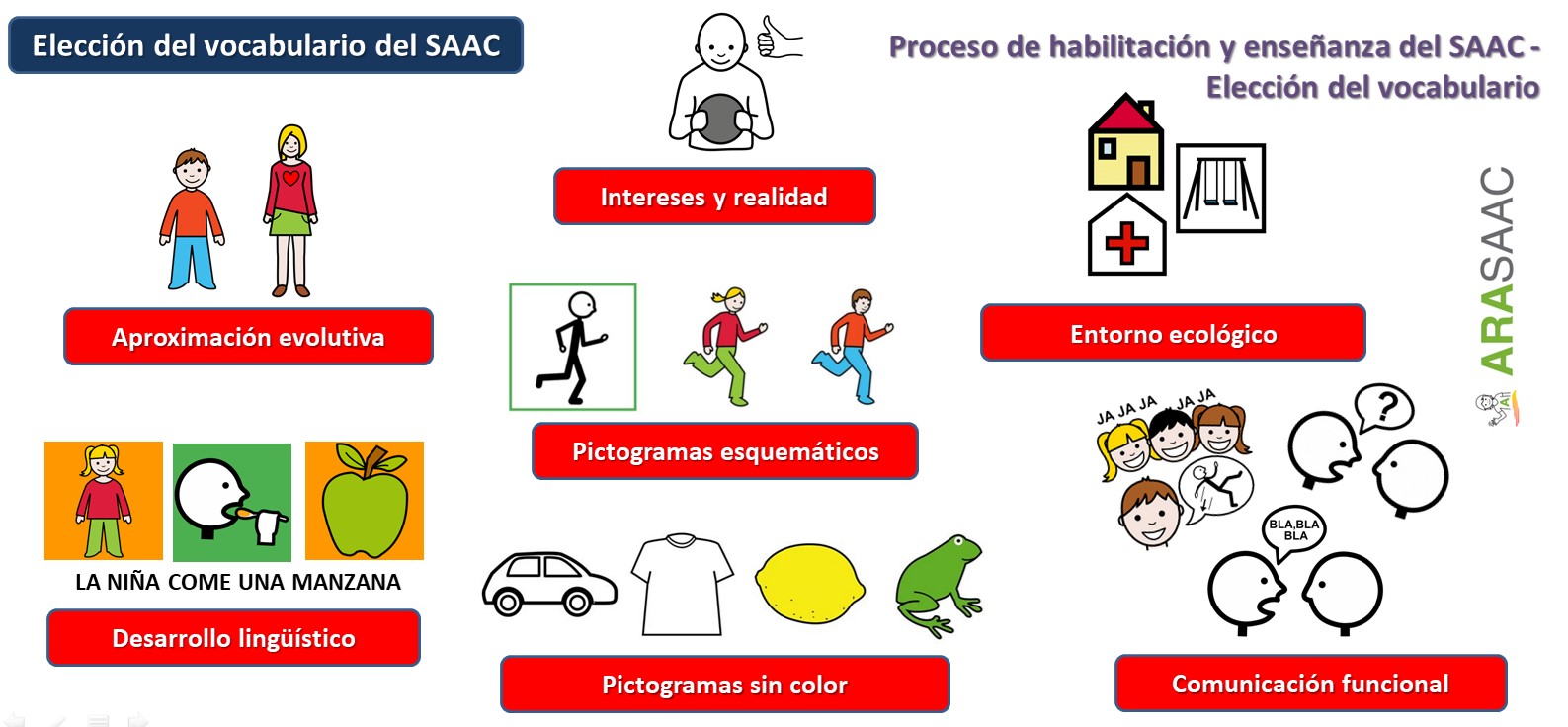
We must not forget that empowerment andteaching should be directed both to the person and to their environment, including all the contexts in which they participate or wish to participate, as well as all significant people in these contexts, including professionals and, above all, family members. , colleagues and friends. This teaching must be carried out in educational and therapeutic environments but also in natural environments, in a 24-hour approach that guarantees that the person will be immersed in a good language environment, surrounded by sensitive and competent interlocutors, and involved in interesting and enriching activities.
To promote the success of the intervention with SAAC, the most important thing is that the person has the means and the vocabulary to say everything they want and that to generate messages it is essential that they participate actively in any activity. Thus life experiences are created that the person experiences, experiences and will want to share with others. This objective should not be left to chance but must be achieved through the effort and success of competent professionals, supported by a society in which there is increasing visibility of the AAC as an effective means to participate and socialize. .
2. WORKING DIFFERENT PHASES FOR THE TEACHING AND HABILITATION OF THE AAC
2.1 Exchanging images (photographs or ARASAAC symbols) for familiar objects or for motivating activities.
Activity 1 – Object: ball – Pictogram: ball
In order to be able to work this phase properly, we are going to create a relaxed atmosphere with few distractions that could interfere with the exchange activity.
We are going to use a familiar object or an activity that is motivating for the user, for example, a toy that we are going to use in the following activities. We will also use a laminated card on which we have printed a photograph or a pictogram, taking into account the cognitive capacity of the user, representing the object or activity. In our tutorial and from now on, we are going to use the term pictogram to refer to the image.

To obtain the toy, the user must give us the pictogram that represents it and that we have placed within reach. We use gestural aids (pointing to the object) or oral (“give me the …”) to facilitate the intervention.
Once the pictogram is delivered, we exchange it for the toy and use oral messages to congratulate him on having achieved it.

In this activity, another person may be present who acts as a “shadow” of the user, providing the necessary gestural aids to hand over the pictogram and obtain the toy. These aids will gradually decrease, until they disappear completely, when the user understands the objective of the exchange activity.
In a later phase, when we have achieved the pictogram-toy association, we can place the pictogram, always visible and accessible, in different places in the room. The user must travel to get it and hand it over so that we can give him the toy.
2.2 Interacting with different interlocutors in everyday settings to generalize learning.
Activity 1 – Object: ball -Pictogram: ball
Once the user understands the process of exchanging the picogram for the object or activity, we must generalize this learning to new interlocutors and to the different environments where it usually operates.
To ensure generalization in this phase, people with whom the user maintains daily contact in the center (hearing and language teacher or speech therapist, therapeutic pedagogy teacher, tutor, occupational therapist, etc.) must intervene. ).
Once the appropriate results have been obtained in the center, we can extend this generalization to the family environment.

It is essential that the user understand that they must make the request for the object or activities only at certain times and during a certain period of time.
2.3 Introducing new objects and activities to work on the identification and choice of the pictogram.
Activity 1 – Object: ball – Pictograms: ball and apple.
We are going to introduce two pictograms for a single object or activity, using a new pictogram that does not correspond to the semantic category of toys, for example, an apple. In this way, we ensure that the discrimination of the pictogram representing the ball is easier for you.

We place the two pictograms in front of the user and in front, the ball. The objective of the activity is for him to request the ball using the corresponding pictogram. Initially, we can use some gestural or oral help to facilitate the choice if we see that it presents difficulties.
Activity 2: Objects: ball – Pictograms: ball and teddy bear.
In the following activity, we use the pictogram of the ball and add the pictogram of another object that belongs to the same semantic category, for example, a teddy bear. We place the pictograms of the ball and the teddy bear in front of the user.
The teddy bear is not in his line of sight, because we want him to request the ball.
Activity 3: Objects: ball and teddy bear – Pictograms: ball and teddy bear.
At this point, we can begin to use two objects of the same semantic category and the two corresponding pictograms to make alternative choices.
To achieve the objective, we place the two pictograms in front of the user and in front, the ball and the teddy bear. Depending on the pictogram you give us, you will get the toy corresponding to the pictogram.

At this time, our main objective is for the user to make alternative choices based on discrimination and choosing different pictograms with different results.
2.4 We create communication boards using different supports to increase vocabulary.
As we introduce new pictograms associated with objects or activities, we will need a basic support (communication notebook) ortechnological (a mobile device) to organize and work on vocabulary.
Our recommendation is to start with a basic support adapted to the capacities of our user, which contains the vocabulary necessary and appropriate to the person, according to their age, interests and social environment in which they develop and participate.

We will always have the opportunity to use a device with specific communication software, when we consider that progress is satisfactory. It is important to note that many users acquire oral language using a basic support without the need to use technological supports.
In the event that we use a technological support, we must always have a printed communication notebook prepared to avoid unforeseen events (exhausted battery, screen breakage, loss of the device, etc.).
Next, we link you to thistutorial of the ARASAAC Open Classroom, where you will find more detailed information on the selection of vocabularyand the elaboration of the communication notebook with pictograms with cumulative phrase.
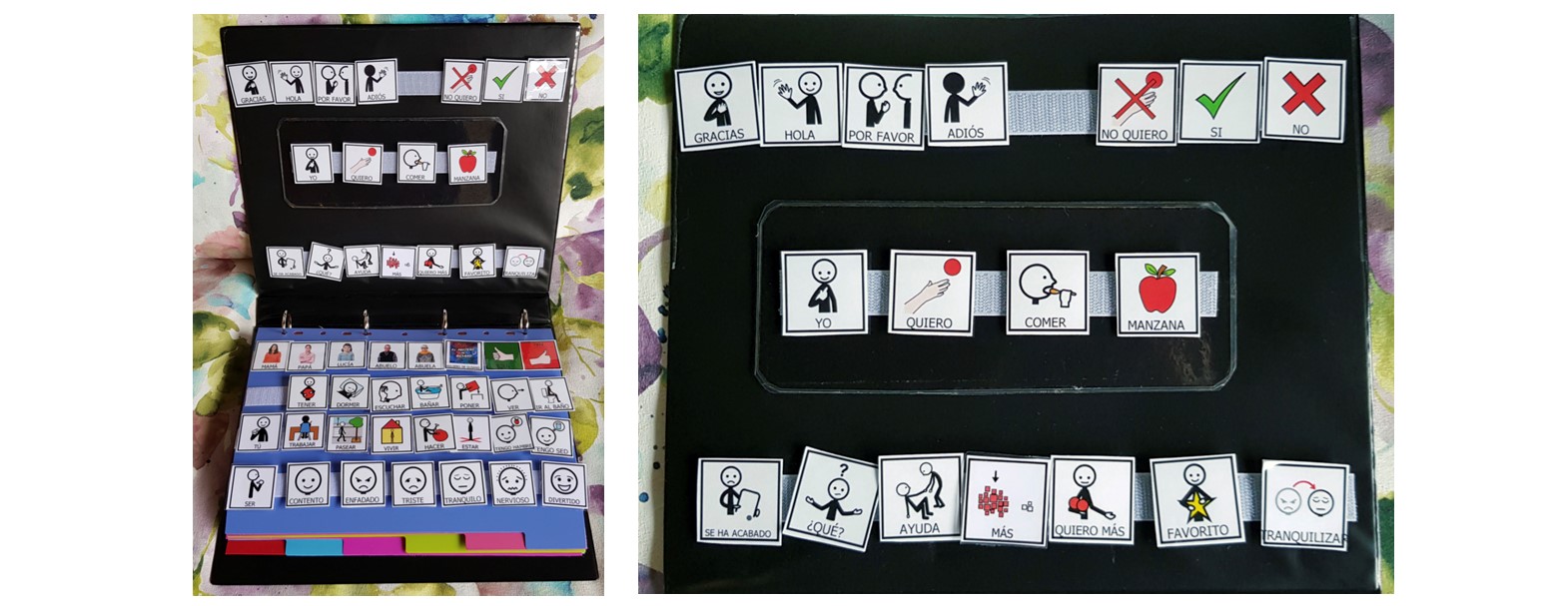
We must bear in mind that this communication notebook could be an advanced example. Our communication notebook must be individualized and adapt to the characteristics and capacitiesof the user and will evolve with the assessment of the progress made.
2.5 We learn to create simple sentences and stimulate the appearance of narrative discourse.
Initially, our notebook will consist of a few pictograms, usually nouns and actions. When the user places an “apple” in the space for the accumulated sentence, the message can take on the meaning of “I want to eat an apple.”

From now on, we must combine the pictograms of actions and nounsthat we have worked on orintroduce new pictograms associated with different types of words (pronouns, adjectives, courtesy formulas, etc.) to work on increasingly complex syntactic structures, which facilitate narrative discourse.
Next, we show you some syntactic structures that we can generate to develop the narrative discourse. In this first example, we have used glyphs with a white background to save ink when printing.

In the following examples, we have used pictograms with the colored background associated with the “Fitzgerald key“.


We leave the use of pictograms with a white background or with a colored background to your choice, although the use of pictograms with a colored background may help some users to identify and associate the pictograms with the different types of words (verbs, nouns , adjectives, etc.) which can facilitate its use.
2.6 We use our SAAC to participate fully and on equal terms in any activity of daily life.
Thehabilitation and teaching of a AAC must be directed both to the person and to his environment, including all the contexts in which he participates or wishes to participate, as well as to all significant people in these contexts, including professionals and, above all, family members. , colleagues and friends.
It is very important to ensure that the person using the AAC has interesting things to communicate to others and that they can fully participate in any activity of daily life in which language acquires its greatest relevance: expressing needs and feelings, having a conversation, requesting information, communicating emotions, facilitating social contact, enjoying leisure, etc.
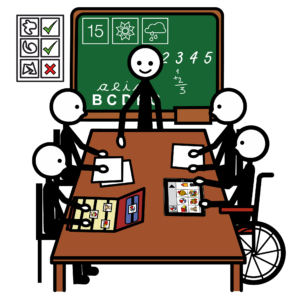
To achieve this goal, teaching must take place in educational and therapeutic settings, but also in the context of the Natural Environments, in a 24 hours that guarantees that the person will be immersed in a Good language environment, surrounded by sensitive and competent interlocutors, and involved in interesting and enriching activities.
The success of the intervention with AAC should not be left to chance, but must be achieved through the effort and success of competent professionals and the family, supported by a society that is increasingly aware and free of prejudices.
3. INTERLOCUTORS COMMITTED TO INCREASED AND ALTERNATIVE COMMUNICATION
Communicating is a social activity in which at least two people participate. Sender and receiver share a leading role in the conversation and both exchange mutual information that allows them to know their opinions, ideas, feelings, suggestions or explanations. We are all potential interlocutors of people who use augmentative and alternative communication.
The interlocutors of people who use alternative systems – augmentatives of communication must be active participants in the communicative interaction. Through shared communication, it is known what the person is like as a whole, from their sense of humor or their state of mind to their interests, hobbies and dreams for the future.
Although the people from their closest environment will be the most common interlocutors, it is very important that society becomes aware of and knows these means of communication, since their generalization, visibility and frequent use in any context, will allow the people who use them to be able to express themselves and actively participate in all the activities in which they develop.
The more you interact with the person, the better knowledge we will have of their form of communication. However, and taking into account the stage of the life cycle in which they are, as well as their capacities, difficulties, etc., the learning and use of the communication system will vary and the interlocutor must take it into account. For example, participating in peer groups is very enriching and offers the opportunity to interact with people of the same age, with whom you have more affinity and share interests.
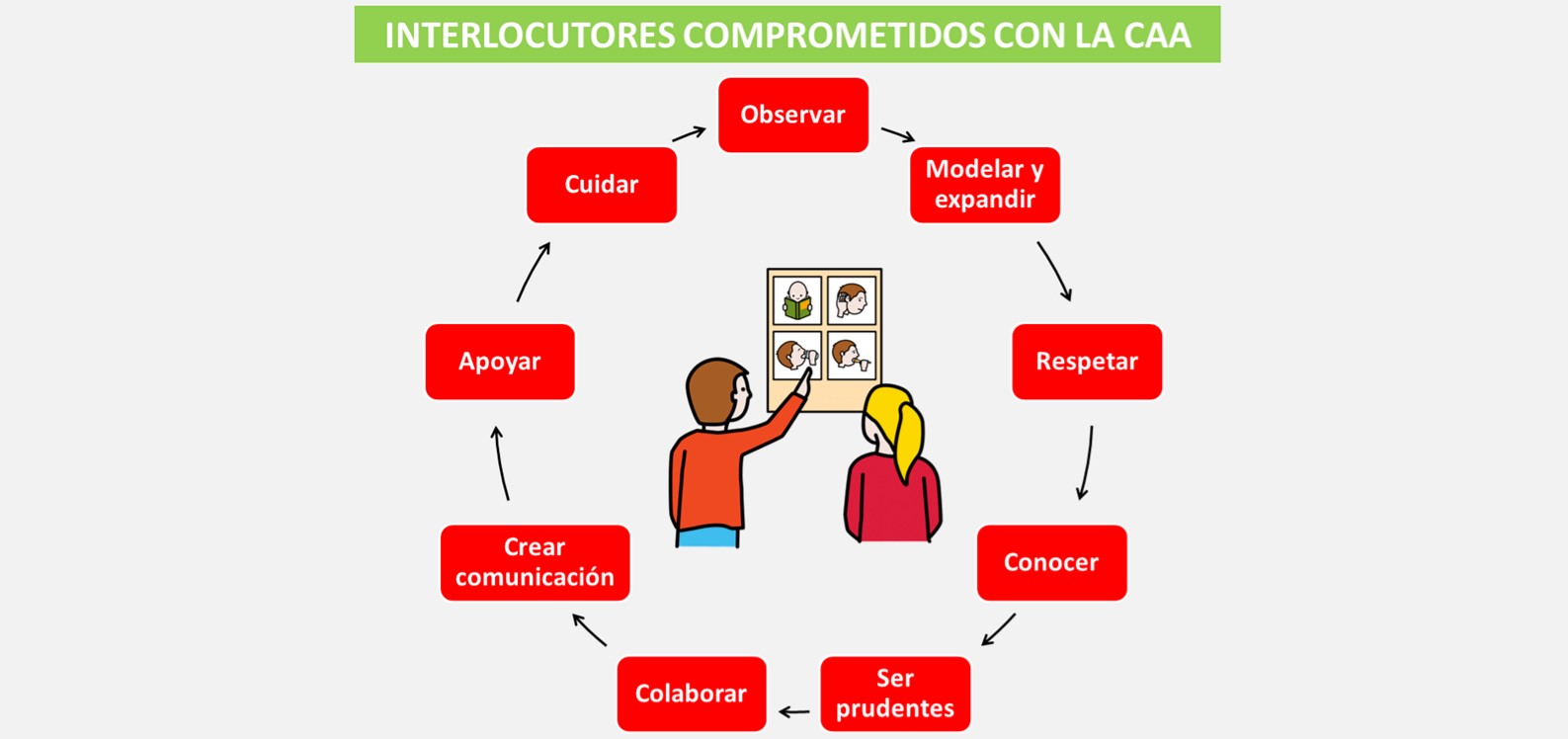
Here are some tips to make it easier to interact with people using a SAAC.
Observe
It is important to know how you communicate, (eg if in addition to the communication program you use any gesture or verbalization).
As interlocutors, we have to observe your facial and body expression, because gestures, looks or smiles can offer a lot of information about how you feel, what you want to tell us, if you like or dislike something, or if we are understanding what you want to communicate.
It is also important to know how you express your affirmative and negative answers. However, in order to enrich communication, expand vocabulary, learn uses of the language, etc., it is advisable to converse using open questions.
Be prudent
Do not assume that communication difficulties imply that the person does not know what they want to say or does not have the linguistic competence to express themselves. Sometimes the statements he makes are ungrammatical (the order of the images is not correct) or they only consist of one image. However, that does not mean that you do not know what you want to tell, since it is possibly something that interests you, a lived or future experience, something you need, etc.
Model and expand
As interlocutors we are a communicative model. If we share the same communication system, we are sharing the same code and we offer a “linguistic – communicative” model of reference. Furthermore, if in our conversation we take the opportunity to offer an “extended linguistic model” of the message, we are favoring its learning.
E.g. Child pointing to the pictogram: PLUS; Interlocutor. Pictograms indicated on the communicator while verbalizing: DO – YOU – WANT – MORE – WATER?
Know
We must know what the communication system is like, what it consists of, how it works, how it is managed and what we can contribute as interlocutors so that it evolves. For example, what new vocabulary is necessary, or eliminate the one that is hardly used. Also to know what communicative functions the person presents (eg asking, rejecting) and how they manifest them, what are their likes, preferences, aversions, etc.
Expect
We have to allow time for the person to respond using their communication system. Time for you to think about your answer, search your system for the elements you require, select them with your access product, if it is the case, etc. Time should not be a barrier and we should not show impatience or get ahead of ourselves, trying to guess what it means.
Take advantage of and create communication opportunities
Any moment is good to talk, chat and create a unique communicative moment, in which we must give the opportunity to use the communication system. With open questions that promote the use of different communication functions, we encourage the development of these skills and enhance the interest in communicating. The communication system is designed and shared with the person. And as interlocutors, we must create a context that listens, attends, stimulates and participates in communication.
Respect
Quando uma pessoa utiliza um produto assistivo para comunicar uma opinião, um desejo, uma ideia, etc., devemos, como interlocutores, respeitar este modo alternativo de expressão e manter uma atitude de escuta ativa e comprometida. A pessoa deve perceber que com seus meios de comunicação pode mudar o ambiente (por exemplo, alcançar objetivos, compartilhar pensamentos). Se, por outro lado, como interlocutores permanecermos indiferentes a esse meio de expressão e ao seu conteúdo, a pessoa deixará de utilizá-lo, pois não será útil.
Colaborar
Um sistema de comunicação é dinâmico e participativo. We must motivate the person to always carry their communication system, and use it when they want to tell us something.
The interlocutors play an essential role with the person and their reference professionals, regarding the design of the communication system, observing and exchanging opinions about the messages that can be more functional or detecting and anticipating possible communication needs.
4. SUPPORT INSTRUMENTS AND TOOLS
In this section, with your collaboration, we will refer to some evaluation tools that can help us to qualitatively determine the capacities and strengths of the user with whom we are going to enable the teaching of SAAC:
- Communication Matrix, published in 1990 and revised in 2004 by Dr. Charity Rowland of the Oregon Health & Science University. The Communication Matrix is an assessment tool designed to determine exactly how a person communicates and to provide a conceptual framework for determining goals for functional communication.
